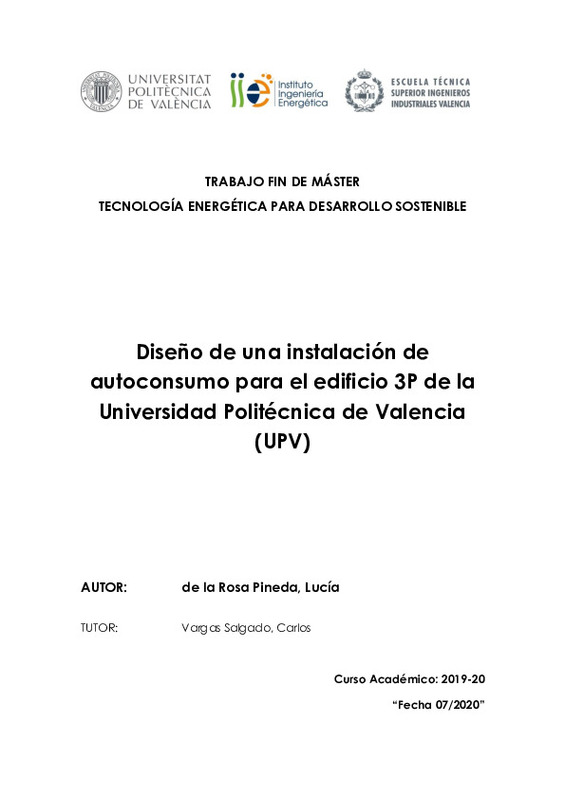|
Resumen:
|
[ES] La aprobación del RD244/2019 ha supuesto un impulso al autoconsumo eléctrico. La energía solar fotovoltaica es el recurso más utilizado, aunque el RD incluye a otras fuentes como la energía eólica.
Se propone el ...[+]
[ES] La aprobación del RD244/2019 ha supuesto un impulso al autoconsumo eléctrico. La energía solar fotovoltaica es el recurso más utilizado, aunque el RD incluye a otras fuentes como la energía eólica.
Se propone el diseño de un sistema de generación eléctrica basado en energías renovables para el abastecimiento de la Escuela Técnica Superior de Ingeniería Agronómica y del Medio Natural (Edificio 3P) de la Universitat Politècnica de València (UPV).
Las tecnologías analizadas son la energía solar fotovoltaica y la eólica de pequeña escala. Al tratarse de recursos muy condicionados por la climatología se requiere una base de datos climáticos y el uso de herramientas como System Advisor Model (SAM) o Excel para el análisis de éstos y su aprovechamiento. Para encontrar la solución planteada se han analizado diferentes alternativas tanto para la parte fotovoltaica como para la eólica.
La instalación tendrá una potencia total de 979kW, siendo la fotovoltaica 859kW y la eólica 120kW. Se ha utilizado todo el espacio disponible en la cubierta para la ubicación de los paneles. Los excedentes generados se utilizan para disminuir el consumo del resto de la universidad. El sistema fotovoltaico estará formado por 2120 paneles y 8 inversores de 100kW, mientras el sistema eólico contará con 60 aerogeneradores y 12 inversores de 10kW. Se obtendría una generación anual de 1485,9MWh. El Edificio 3P autoconsumiría 404 MWh, el resto sería vertido a la UPV y autoconsumido en su totalidad. El nuevo consumo de la red eléctrica por parte del Edificio 3P sería de 150MWh anuales. Para el proyecto se requeriría una inversión inicial de 1.264.055 € teniendo un payback de 9 años.
La instalación planteada es capaz de producir suficiente energía para abastecer el Edificio 3P. Si se ampliase la instalación a todas las cubiertas de la UPV sería posible abastecer la mayor parte de su consumo.
[-]
[EN] The approval of RD244 / 2019 has been a boost to electric self-consumption. Photovoltaic solar energy is the most used resource, although the order includes other sources such as wind energy.
This project proposes ...[+]
[EN] The approval of RD244 / 2019 has been a boost to electric self-consumption. Photovoltaic solar energy is the most used resource, although the order includes other sources such as wind energy.
This project proposes the design of a system of electrical generation based on renewable energies for the supply of the Higher Technical School of Agronomic Engineering and the Natural Environment (Building 3P) of the Polytechnic University of Valencia (UPV).
The technologies analyzed are photovoltaic solar energy and small-scale wind energy. As they are resources highly conditioned by climatology, a climate database and the use of tools such as System Advisor Model (SAM) or Excel are required for their analysis and harnessing. To find the proposed solution, different alternatives have been analyzed for both the photovoltaic and the wind part.
The installation will have a total power of 979kW, with 859kW photovoltaic and 120kW wind power. All available space on the roof of the building has been used for the location of the panels. The surpluses generated are used to decrease consumption by the rest of the university. The photovoltaic system will consist of 2120 panels and 8 inverters of 100kW of capacity, while the wind system will have 60 wind turbines and 12 inverters of 10kW of capacity. The annual generation obtained would be 1485.9MWh. The Building 3P would consume 404 MWh, the rest would be discharged to the UPV, so all energy produced will be consumed. The new consumption of the electricity grid by Building 3P would be 150MWh per year. For the project, an initial investment of 1,264,055 € would be required, with an 8-year payback.
The proposed installation is capable of producing enough energy to supply Building 3P. If the installation was extended to all the UPV roofs, it would be possible to supply most of the consumption of the university.
[-]
|







